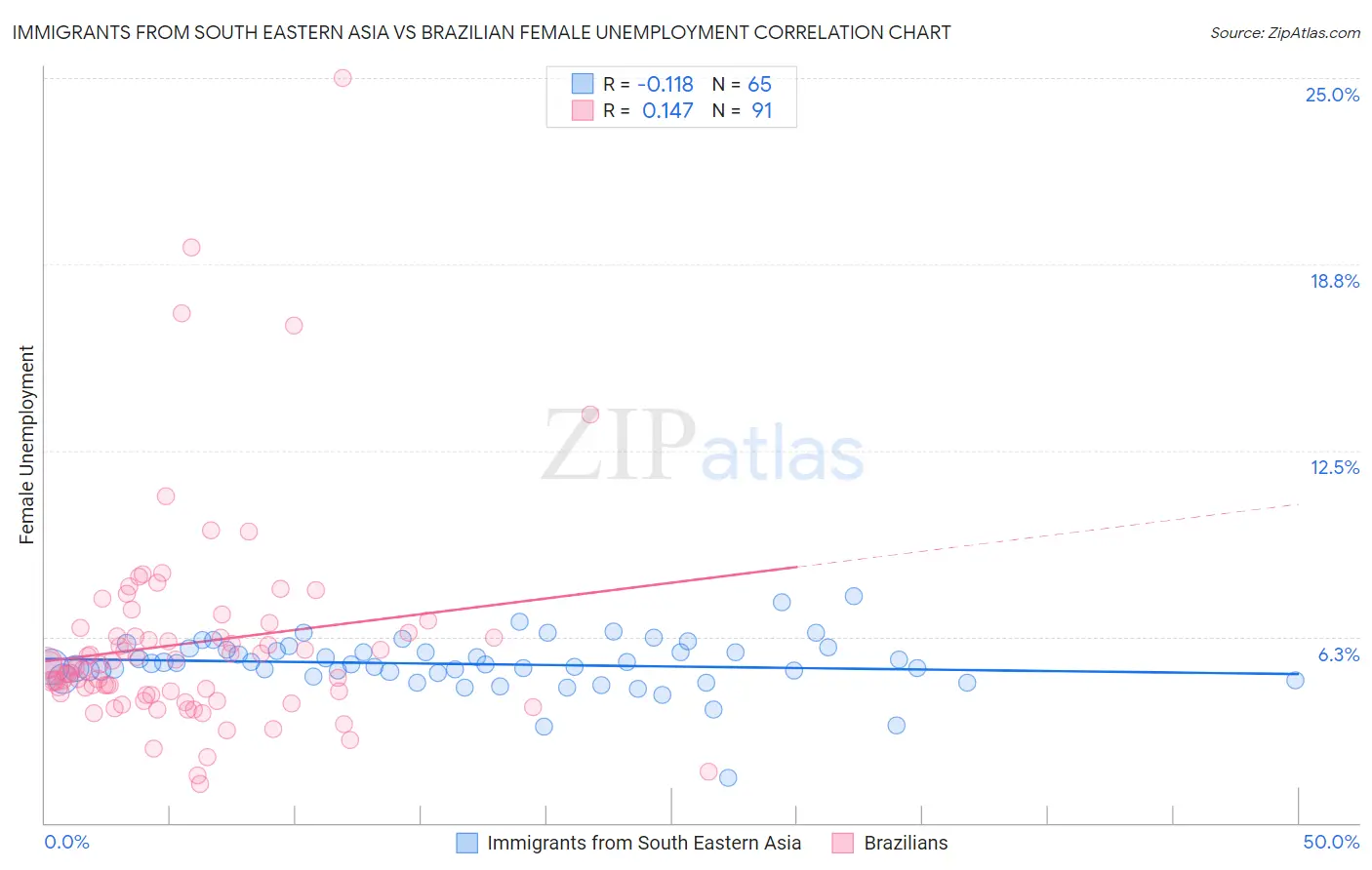Immigrants from South Eastern Asia vs Brazilian Female Unemployment
COMPARE
Immigrants from South Eastern Asia
Brazilian
Female Unemployment
Female Unemployment Comparison
Immigrants from South Eastern Asia
Brazilians
5.4%
FEMALE UNEMPLOYMENT
20.3/ 100
METRIC RATING
203rd/ 347
METRIC RANK
5.5%
FEMALE UNEMPLOYMENT
7.3/ 100
METRIC RATING
221st/ 347
METRIC RANK
Immigrants from South Eastern Asia vs Brazilian Female Unemployment Correlation Chart
The statistical analysis conducted on geographies consisting of 507,584,627 people shows a poor negative correlation between the proportion of Immigrants from South Eastern Asia and unemploymnet rate among females in the United States with a correlation coefficient (R) of -0.118 and weighted average of 5.4%. Similarly, the statistical analysis conducted on geographies consisting of 323,090,102 people shows a poor positive correlation between the proportion of Brazilians and unemploymnet rate among females in the United States with a correlation coefficient (R) of 0.147 and weighted average of 5.5%, a difference of 1.7%.

Female Unemployment Correlation Summary
| Measurement | Immigrants from South Eastern Asia | Brazilian |
| Minimum | 1.5% | 1.3% |
| Maximum | 7.6% | 25.0% |
| Range | 6.1% | 23.7% |
| Mean | 5.3% | 6.0% |
| Median | 5.3% | 5.3% |
| Interquartile 25% (IQ1) | 5.0% | 4.3% |
| Interquartile 75% (IQ3) | 5.8% | 6.4% |
| Interquartile Range (IQR) | 0.85% | 2.1% |
| Standard Deviation (Sample) | 0.92% | 3.6% |
| Standard Deviation (Population) | 0.91% | 3.6% |
Demographics Similar to Immigrants from South Eastern Asia and Brazilians by Female Unemployment
In terms of female unemployment, the demographic groups most similar to Immigrants from South Eastern Asia are Iroquois (5.4%, a difference of 0.040%), Immigrants from Israel (5.4%, a difference of 0.060%), Immigrants from Afghanistan (5.4%, a difference of 0.13%), Immigrants from Brazil (5.4%, a difference of 0.15%), and Creek (5.4%, a difference of 0.50%). Similarly, the demographic groups most similar to Brazilians are Nicaraguan (5.5%, a difference of 0.020%), Immigrants from Africa (5.4%, a difference of 0.25%), South American (5.4%, a difference of 0.26%), Bermudan (5.4%, a difference of 0.33%), and Peruvian (5.4%, a difference of 0.43%).
| Demographics | Rating | Rank | Female Unemployment |
| Iroquois | 20.8 /100 | #202 | Fair 5.4% |
| Immigrants | South Eastern Asia | 20.3 /100 | #203 | Fair 5.4% |
| Immigrants | Israel | 19.7 /100 | #204 | Poor 5.4% |
| Immigrants | Afghanistan | 18.9 /100 | #205 | Poor 5.4% |
| Immigrants | Brazil | 18.8 /100 | #206 | Poor 5.4% |
| Creek | 15.4 /100 | #207 | Poor 5.4% |
| Immigrants | Costa Rica | 13.7 /100 | #208 | Poor 5.4% |
| Koreans | 13.4 /100 | #209 | Poor 5.4% |
| Choctaw | 12.3 /100 | #210 | Poor 5.4% |
| Ottawa | 11.6 /100 | #211 | Poor 5.4% |
| Uruguayans | 11.4 /100 | #212 | Poor 5.4% |
| Samoans | 10.6 /100 | #213 | Poor 5.4% |
| Seminole | 10.3 /100 | #214 | Poor 5.4% |
| Immigrants | Nicaragua | 10.2 /100 | #215 | Poor 5.4% |
| Comanche | 10.0 /100 | #216 | Poor 5.4% |
| Peruvians | 9.6 /100 | #217 | Tragic 5.4% |
| Bermudans | 9.0 /100 | #218 | Tragic 5.4% |
| South Americans | 8.6 /100 | #219 | Tragic 5.4% |
| Immigrants | Africa | 8.5 /100 | #220 | Tragic 5.4% |
| Brazilians | 7.3 /100 | #221 | Tragic 5.5% |
| Nicaraguans | 7.2 /100 | #222 | Tragic 5.5% |